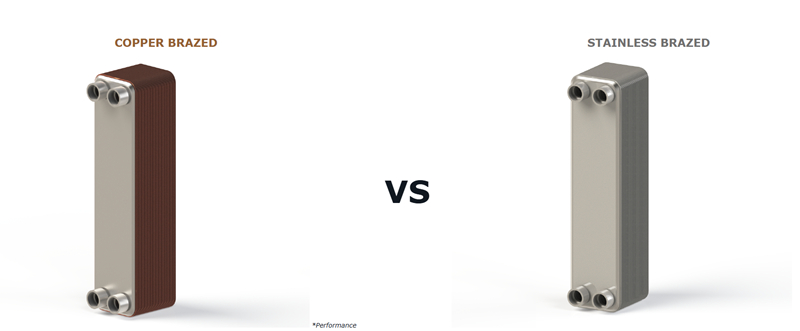- Menu
- Search For Product Models
Search For Product Models
- cn

Brazed plate heat exchangers (BPHE) rely on a filler metal to permanently bond stainless-steel plates together under vacuum or controlled atmosphere. The most widely used filler materials are copper (Cu) and nickel-based stainless-steel brazing alloys. Though they share the same structural principle, the choice of brazing material determines the exchanger’s temperature resistance, corrosion behavior, and application suitability.
钎焊板式换热器通过钎料在真空或保护气氛下将不锈钢板永久连接。最常用的钎料为铜基钎料与镍基不锈钢钎焊材料。虽然结构原理相同,但钎料的不同决定了换热器的耐温性能、耐蚀性及应用范围。
Aspect 项目 | Copper Brazing 铜钎焊 | Stainless-Steel (Nickel) Brazing 不锈钢(镍基)钎焊 |
Typical filler 钎料 | Pure copper or Cu-based alloy | Nickel-based or iron-nickel alloy |
Brazing temperature 钎焊温度 | ~1080 °C | 1100–1200 °C |
Base material 母材 | AISI 304/316L | AISI 316L, duplex, or high-alloy steels |
Corrosion resistance 耐腐蚀性 | Good for neutral/non-aggressive media | Excellent for corrosive or chloride-rich fluids |
Mechanical strength 机械强度 | Moderate; limited above 200 °C | Higher; stable up to 600 °C |
Thermal conductivity 导热性 | Very high (Cu = 390 W/m·K) | Lower (Ni ≈ 90 W/m·K) but uniform at high temperature |
Cost 成本 | Economical | Higher due to nickel alloy and vacuum brazing complexity |
**Copper-Brazed BPHE 铜钎焊型**
· • Excellent thermal efficiency due to high copper conductivity.
· • Ideal for HVAC, refrigeration, and water-based heating systems.
· • Compact and cost-effective for medium pressure applications (≤ 45 bar).
· • Sensitive to ammonia, sulphur compounds, and chlorides.
**Stainless-Steel/Nickel-Brazed BPHE 不锈钢(镍)钎焊型**
· • Superior chemical resistance against ammonia, seawater, glycols, organic acids, and CO₂.
· • Suitable for high-temperature and high-pressure processes (up to 600 °C, 100 bar).
· • Longer service life in industrial, marine, and food-grade environments.
· • Slightly lower heat-transfer rate but compensated by reliability and durability.
Copper-Brazed Units 铜钎焊型 | Nickel-Brazed Units 镍钎焊型 |
Heat pumps & chillers | Ammonia evaporators & condensers |
Domestic water heating | Seawater coolers & brine systems |
Oil coolers & compressor intercoolers | Chemical & food process equipment |
Refrigeration systems (R410A, R134a) | CO₂ and HFC/HFO refrigeration systems |
· • Copper brazing continues to dominate HVAC and standard industrial markets due to low cost and proven reliability.
· • Stainless-steel (nickel) brazing is expanding in ammonia, marine, hydrogen, and CO₂ systems due to corrosion resistance and sustainability.
· • Hybrid and diffusion-bonding technologies are emerging for extreme environments.
· • Future trends include AI-based design, laser-brazing precision, and recyclable materials for sustainable manufacturing.
Both copper and stainless-steel brazing technologies have distinct strengths. Copper brazing offers unmatched efficiency and cost-effectiveness for standard HVAC applications, while nickel/stainless-steel brazing provides reliability under extreme conditions. The global trend points toward diversification — applying each technology in its most suitable environment for performance and sustainability.
铜钎焊与不锈钢钎焊各具优势。铜钎焊以高效与经济性在常规暖通领域占主导,而镍钎焊凭借高耐蚀与高温性能在工业与新能源领域快速扩展。未来发展将更加多元化,使每种技术在最适宜的环境中发挥最大效能与可持续价值。